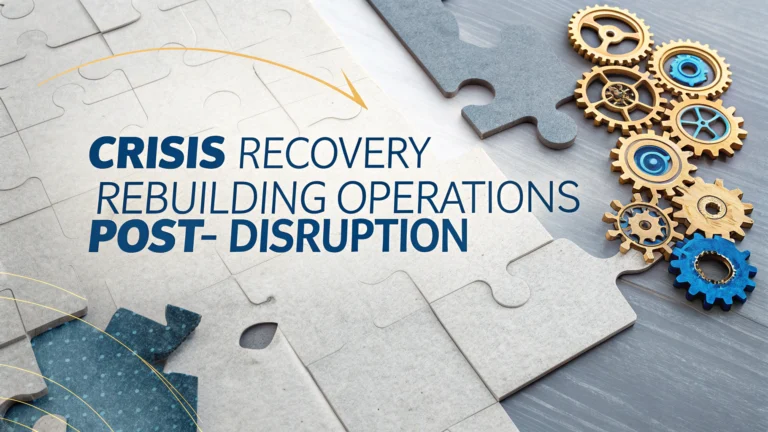Restoring operations after a major disruption requires a structured approach that balances speed with strategic planning.
Organizations must focus on both immediate recovery needs and long-term resilience building to emerge stronger from crisis situations.
This guide outlines proven strategies for COOs and business leaders to rebuild operations effectively while maintaining business continuity.
Initial Response Steps
- Assess damage and impact on core business functions
- Activate emergency response teams and protocols
- Establish clear communication channels with stakeholders
- Document all decisions and actions taken
Prioritizing Recovery Actions
Create a tiered recovery plan that addresses mission-critical operations first.
| Priority Level | Operations Type | Timeline |
|---|---|---|
| High | Revenue-generating activities | 0-24 hours |
| Medium | Support functions | 24-72 hours |
| Low | Non-essential activities | 3-7 days |
Resource Management
- Reallocate staff to priority areas
- Identify alternative suppliers and resources
- Secure emergency funding if needed
- Implement temporary workarounds
Technology Recovery
Restore essential systems using backup data and redundant infrastructure.
Key Technology Focus Areas:
- Data recovery and validation
- Network infrastructure
- Communication systems
- Customer-facing platforms
Supply Chain Restoration
- Map affected supply chain components
- Contact key suppliers and partners
- Identify alternative sourcing options
- Adjust inventory management strategies
Employee Support and Communication
Keep staff informed through regular updates and clear directives.
Communication Channels:
- Emergency notification system
- Company intranet
- Team messaging platforms
- Regular virtual meetings
Financial Management During Recovery
- Review insurance coverage and claims
- Track recovery expenses separately
- Adjust cash flow projections
- Identify cost-saving opportunities
Building Future Resilience
Document lessons learned and update business continuity plans accordingly.
Key Improvements:
- Enhanced backup systems
- Diversified supplier base
- Regular crisis response training
- Updated emergency protocols
Moving Forward Stronger
Transform recovery efforts into opportunities for operational improvements and enhanced business resilience.
Contact your local business continuity planning association for additional guidance and resources: Disaster Recovery Institute International.
Stakeholder Relations Management
Maintaining strong relationships with key stakeholders during recovery is crucial for long-term success.
Key Stakeholder Groups:
- Customers and clients
- Investors and shareholders
- Regulatory bodies
- Local communities
Quality Assurance and Compliance
Implement robust monitoring systems to maintain service standards during recovery.
- Regular quality audits
- Compliance checkpoints
- Performance metrics tracking
- Customer feedback collection
Risk Mitigation Strategies
Develop comprehensive risk management frameworks to prevent future disruptions.
Focus Areas:
- Operational vulnerabilities
- External threat assessment
- Insurance coverage optimization
- Crisis response capabilities
Sustainable Recovery Framework
Implement long-lasting improvements that enhance organizational resilience.
- Digital transformation initiatives
- Process automation opportunities
- Workforce skill development
- Environmental sustainability measures
Securing Organizational Success
Transform disruption into opportunity by embedding resilience into organizational DNA. Focus on continuous improvement and adaptability to ensure stronger operations for the future.
Remember that recovery is not just about returning to normal – it’s about emerging stronger and more capable of handling future challenges.
FAQs
- What are the first critical steps a COO should take immediately after a crisis?
Assess the extent of operational disruption, ensure employee safety, establish a crisis command center, activate business continuity plans, and initiate stakeholder communications protocols. - How should priorities be established during the recovery phase?
Prioritize based on critical business functions, revenue impact, customer needs, and resource availability. Create a tiered recovery system focusing on essential operations first. - What role does data backup and IT infrastructure play in crisis recovery?
They are fundamental to recovery, enabling business continuity through restored systems, recovered data, and reestablished digital operations. Regular testing of backup systems is essential. - How can supply chain resilience be rebuilt after a major disruption?
Diversify suppliers, establish alternate logistics routes, maintain emergency inventory reserves, and develop relationships with backup vendors while strengthening existing partnerships. - What financial measures should be implemented during recovery?
Assess cash flow requirements, negotiate with insurers, review cost-cutting opportunities, secure emergency funding if needed, and develop revised budgets for recovery phases. - How can employee morale and productivity be maintained during rebuilding?
Maintain transparent communication, provide clear direction, offer support resources, implement flexible work arrangements, and recognize employee efforts during recovery. - What metrics should be tracked to measure recovery progress?
Monitor operational capacity, customer retention, employee productivity, financial performance, supply chain stability, and milestone achievement against recovery timeline. - How can operational resilience be strengthened to prevent future crises?
Implement robust risk management systems, develop comprehensive contingency plans, conduct regular crisis simulations, and maintain updated emergency response protocols. - What role does stakeholder communication play in crisis recovery?
Regular updates to employees, customers, suppliers, and investors maintain confidence, manage expectations, and ensure alignment with recovery objectives. - When should temporary solutions be replaced with permanent operational fixes?
Evaluate temporary measures based on cost-effectiveness, operational efficiency, and long-term sustainability, transitioning to permanent solutions when stability and resources allow.
